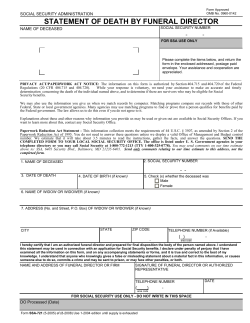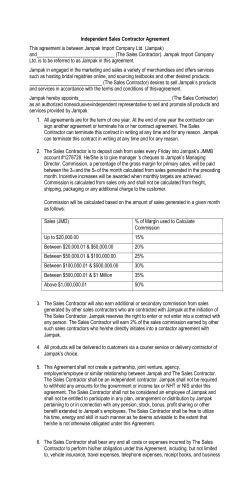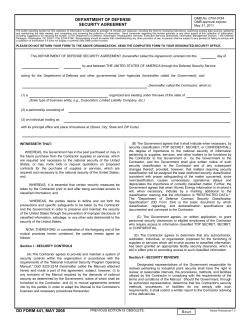
By: Kristin N. Zielmanski Employee or Independent Contractor?
Employee or Independent Contractor? Avoiding Misclassification By: Kristin N. Zielmanski Whether an individual working for your business qualifies as an employee or an independent contractor is a question with no clear answer. This is because the standard for determining an individual’s employment status under Georgia law differs from the standard used by the Internal Revenue Service (IRS). The definitions and tests used to determine employment status also vary among the National Labor Relations Act, the Civil Rights Act, the Fair Labor Standards Act, and the Employment Retirement Income Security Act.1 Given these varying standards, which are factually dependent and largely subjective, classifying workers properly can be confusing for business owners. There is certainly financial incentive for business owners to classify workers as independent contractors. By classifying workers as independent contractors, business owners are not required to withhold payroll taxes, pay other withholdings (i.e., FICA, Medicare), or make payments for state workers’ compensation and unemployment insurance programs. However, it is important for businesses to properly classify their workers because misclassifying workers as independent contractors rather than employees can be a costly mistake. If a worker is misclassified, either the Georgia Department of Labor or the U.S. Department of Labor may conduct an investigation and bring an action to establish a business owner’s liability for certain unpaid employment benefits, including matching FICA payroll taxes, workers’ compensation insurance, minimum wages and overtime wages, and unemployment insurance. The frequency of such investigations is likely to increase as the issue of employee misclassification is now coming more into national focus. Just this May 2008, representatives of the U.S. House of Representatives proposed House Bill 6111, which is aimed at preventing employers from improperly classifying employees as “independent contractors” by expressly prohibiting misclassification of employees under the Fair Labor Standards Act.2 Further, with a weakening economy, unemployment claims, which can lead to Department of Labor investigations regarding misclassified workers, are on the rise. Given the greater state and national attention to this issue, Georgia business owners should begin by learning about the standards outlined by the state Employment Security Law and the IRS. 1 U.S. Government Accountability Office, “Employee Misclassification: Improved Outreach Could Help Ensure Proper Worker Classification”, GAO-07-859T, May 8, 2007. 2 “Proposed bill would prevent improper worker misclassification”, Labor & Employment Law, 5/27/08, http://hr.cch.com/news/employment/052708.a.asp. 1 Georgia Employment Security Law Georgia’s Employment Security Law, O.C.G.A. 34-8-1 et seq., requires business owners with employees to pay unemployment insurance contributions for those employees. In contrast, where an individual does not have employment status as defined by the Employment Security Law, the business owner is not liable for such contributions. The test for determining whether the services performed by an individual qualify as employment, or are exempt, is set forth in Code Section 34-8-35(f). The Georgia legislature amended this Code Section last year to recognize situations in which the IRS has already determined that an individual is not an employee, presumably to avoid inconsistent determinations between the Department of Labor and the IRS. The amended state law, however, does not provide a clear test for determining whether an individual’s services qualify as employment and, therefore, whether the business owner is liable for unemployment insurance contributions. Before July 1, 2007, under Georgia law, the test for whether an individual who was paid wages was exempt from employee status consisted of the three following factors:3 (1) the individual has been and will continue to be free from control or direction over the performance of such services, both under the individual's contract of service and in fact; (2) such service is either outside the usual course of the business for which such service is performed, or such service is performed outside of all the places of business of the enterprise for which such service is performed; and (3) the individual is customarily engaged in an independently established trade, occupation, profession, or business. This three-factor test is often termed the “ABC test” and has been adopted by many states across the United States. In fact, in December 2007, the Massachusetts Attorney General slapped Federal Express with a $190,000 fine as a result of Federal Express’s misclassification of its drivers as independent contractors.4 In coming to its conclusion, the Attorney General found that that Federal Express could not establish the three factors in the “ABC test”. The amended Code Section, effective July 1, 2007, provides for two alternative methods for establishing that an individual is exempt from employee status. In the first option, an individual does not qualify as an employee if factors (1) and (3) above can be established. This means that an individual does not qualify as an employee if “[s]uch individual has been and will continue to be free from control or direction over the performance of such services, both under the individual's contract of service and in fact; and [s]uch individual is customarily engaged in an independently established trade, occupation, profession, or business.” 3 Assuming the individual has been paid wages as defined by O.C.G.A. § 34-8-49 (“[A]ll remuneration for personal services, including commissions and bonuses and the cash value of all remuneration paid in any medium other than cash”). 4 Office of the Attorney General Martha Coakley, December 19, 2007, www.mass.gov. 2 Under the second option, an individual will not be considered an employee under Georgia law if “[s]uch individual and the services performed for wages are the subject of an SS-8 determination by the Internal Revenue Service, which decided against employee status.” Oftentimes, business owners do not seek an SS-8 determination from the IRS before the Georgia Department of Labor investigates an individual’s status and reaches its own conclusion that an individual was an employee. At that point, the business owner must be able to establish both prongs of the state law test in order to avoid liability for unpaid unemployment insurance contributions. Whether the first prong of the test—that the individual was free from direction and control—can be established turns on a number of factors. Among the factors considered are whether the individual supplies his or her own equipment, whether the individual is free to set his or her own work hours, and whether the individual is free to come and go as he or she pleases. A signed “Independent Contractor Agreement” certainly supports the argument that an individual is not an employee. No single factor, however, is determinative. The second prong of the test—whether the individual is engaged in an independently established trade, occupation, profession, or business—is particularly confusing and can lead to unpredictability for business owners. Even if the business owner can establish the first prong of the test, the business owner must also establish that the individual is engaged in some other trade, occupation, profession or business. For example, the Supreme Court of Georgia found that this prong was satisfied where the workers were free to sell competitor’s products under their contracts with the fashion show director.5 The Court of Appeals similarly held that this prong was satisfied where the individuals were allowed to represent competitors and also held other full time occupations.6 This element of the test suggests that business owners must take some affirmative steps to insure that the independent contractors working for them, in fact, hold themselves out in occupations outside of their independent contractor relationship. This may include making it a condition of the independent contractor agreement that the contractor work in a separate occupation and providing in the contract that the contractor has the freedom to provide the same services for competitors. IRS 20-Factor Test For purposes of determining whether a worker is an employee for which the business owner must pay federal employment taxes, the IRS test is no less unpredictable and factually dependent than the state law test. In contrast with the state law 3-prong test, the IRS uses a 20 factor test to determine whether an individual is an employee or an independent contractor. The IRS considers the following factors: 5 6 See Sarah Coventry, Inc. v. Caldwell, 243 Ga. 429, 254 S.E.2d 375 (1979). See Vocational Placement Services, Inc. v. Caldwell, 168 Ga.App. 198, 308 S.E.2d 618 (1983). 3 1. Requiring Compliance with Instructions. A worker who is required to comply with other persons’ instructions about when, where, and how he or she is to work is ordinarily an employee. 2. Training. Training a worker indicates that the person or persons for whom the services are performed want the services performed in a particular method or manner. 3. Integration of an Individual’s Services in Business Operations. When the success or continuation of a business depends to an appreciable degree upon the performance of certain services, the workers who perform those services must necessarily be subject to a certain amount of control by the owner of the business. Control is indicative of employment. 4. Services Must Be Rendered Personally. If the services must be rendered personally, presumably the person or persons for whom the services are performed are interested in the methods used to accomplish the work as well as in the results. This is indicative of an employment relationship. 5. Hiring, Supervising, and Paying Assistants. If the person or persons for whom the services are performed hire, supervise, and pay assistants, that factor generally shows control over the workers on the job. 6. Continuing Relationship. A continuing relationship between the worker and the person or persons for whom the services are performed indicates that an employer-employee relationship exists. 7. Set Hours of Work. The establishment of set hours of work by the person or persons for whom the services are performed is a factor indicating control. 8. Full-time is Required. If the worker must devote substantially full time to the business of the person or persons for whom the services are performed, such persons have control over the amount of time the worker spends working and impliedly restrict the worker from doing other gainful work. An independent contractor on the other hand, is free to work when and for whom he or she chooses. 9. Doing Work on Employer’s Premises. If the work is performed on the premises of the person or persons for whom the services are performed, that factor suggests control over the worker, especially if the work could be done elsewhere. This control is also present if the worker is required to travel a designated route, canvass a territory within a certain time, or work at specific places as required. 10. Order or Sequence of Set. If a worker must perform services in the order or sequence set by the person or persons for whom the services are performed, that 4 factor shows that the worker is not free to follow the worker's own pattern of work but must follow the established routines and schedules of the person or persons for whom the services are performed. 11. Requiring Worker to Submit Oral or Written Reports. A requirement that the worker submit regular or written reports to the person or persons for whom the services are performed indicates a degree of control. 12. Payment by Hour, Week, or Month. Payment by the hour, week, or month generally points to an employer-employee relationship whereas payment made by the job or on s straight commission generally indicates that the worker is an independent contractor. 13. Payment of Business and/or Traveling Expenses. If the person or persons for whom the services are performed ordinarily pay the worker's business and/or traveling expenses, the worker is ordinarily an employee. 14. Furnishing of Tools and Materials. The fact that the person or persons for whom the services are performed furnish significant tools, materials, and other equipment tends to show the existence of an employer-employee relationship. 15. Significant Investment. If the worker invests in facilities that are used by the worker in performing services and are not typically maintained by employees (such as the maintenance of an office rented at fair value from an unrelated party), that factor tends to indicate that the worker is an independent contractor. 16. Realization of Profit/Loss. A worker who can realize a profit or suffer a loss as a result of the worker's services, and suffer economic risk, (in addition to the profit or loss ordinarily realized by employees) is generally an independent contractor. The worker who cannot is an employee. 17. Working for More than One Firm at a Time. If a worker performs more than de minimis services for a multiple of unrelated persons or firms at the same time, that factor generally indicates that the worker is an independent contractor. 18. Making Service Available to the General Public. The fact that a worker makes his or her services available to the general public on a regular and consistent basis indicates an independent contractor relationship. 19. Right to Discharge. The right to discharge a worker is a factor indicating that the worker is an employee and the person possessing the right is an employer. An employer exercises control through the threat of dismissal, which causes the worker to obey the employer's instructions. An independent contractor, on the other hand, cannot be fired so long as the independent contractor produces a result that meets the contract specifications. 5 20. Right to Terminate. If the worker has the right to end his or her relationship with the person for whom the services are performed at any time he or she wishes without incurring liability, that factor indicates an employer-employee relationship.7 Of course, the IRS emphasizes that no single factor under the above test is determinative of an individual’s status and each situation is decided on a case-by-case basis. Example To illustrate how the state law test and the IRS test could result in two different outcomes, consider the following example: Under a contract styled “Independent Contractor Agreement,” a sales representative took books on consignment from a Company and sold them "direct to the consumer.” The sales representative had the freedom to set the retail prices for the books, but paid the Company a preset amount for each book. The sales representative’s only compensation was the difference between the paid preset amount and the retail price he selected. The Company did not withhold payroll taxes from the sales representative’s compensation or provide him with benefits such as health insurance or a retirement plan. The Company also did not require the sales representative to work during any set hours or days. In fact, he could take vacations anytime he wanted. While the Company did hold some training sessions and meetings, attendance at them was optional for the sales representatives. The Company did not provide the sales representative with an office or showroom nor did it provide him with equipment such as phones, computers, or office supplies. The Company also did not reimburse him for any of his expenses, including his supplies, advertising, or travel expenses. Furthermore, the Company did not prohibit the sales representative from selling any of the competitors' books or merchandise at the same time he sold the Company’s books. The Company did give each sale representative a designated sales territory and encouraged a minimum number of sales. In addition, the sales representatives generally came by the Company’s office on a weekly basis to submit book inventory reports.8 When this factual scenario was presented before the Georgia Court of Appeals in 1996, the Court upheld the Department of Labor’s determination that the sales 7 8 Revenue Ruling 87-41, Employment Status Under Section 530(D) of The Revenue Act of 1978. See American Book Display v. Poythress, 223 Ga.App. 899, 479 S.E.2d 198 (1996). 6 representative was an employee under the Employment Security Law.9 In affirming the determination, the Court of Appeals found that because the sales representative’s services included in-office inventory pickup of books as well as the weekly sales receipt return, the sales representatives services were not performed ‘outside of all the places of business of’ the Company as required by the second prong of the test. 10 Therefore, the Company could not establish all three prongs of the (pre-July 2007) state law test and incurred liability.11 As discussed earlier, the second (and fatal) prong for this factual scenario has since been eliminated. However, had the Court of Appeals addressed the third prong of the test (it stopped at the second), it could have still concluded that the sales representative was an employee. If there was no evidence that the sales representative had another full-time job, or an independently established occupation, trade, or profession, outside of selling books, the Company would not have been able to satisfy the third prong of the state law test. Evaluating the same factual scenario under the 20-factor IRS test, one can see how the sales representative could be classified as an independent contractor. Of the 20 factors listed above, only factors #9 (the Company controlled the location of the sales territory) and #11 (the requirement of written weekly sales reports), weigh in favor of an employment relationship. The remaining facts indicate that the sales representative was free from any of the Company’s control and, therefore, an independent contractor. In particular, the sales representative had freedom to set prices and suffer economic risk in his book sales. He provided all of his own supplies and equipment and was never reimbursed. He did not have to follow any method or sequence in selling the books, nor was he subject to any supervision. Resolving Questions Given that the test outlined by state law varies from the test established by the IRS such that inconsistent determinations can result, business owners are not necessarily left with clear direction in classifying their workers. If you, as a business owner, have significant questions, you may consider consulting with an attorney. You may also consider filing a Form SS-8 “Determination of Worker Status for Purposes of Federal Employment Taxes and Income Tax Withholding” with the IRS for guidance on the issue. Requesting an SS-8 determination involves filling out a Form SS-8 questionnaire, which essentially walks the person making the inquiry through the above IRS 20-factor test. The IRS then issues a determination letter regarding whether workers are employees or independent contractors. While the IRS does not issue a determination letter for proposed transactions or on hypothetical situations, it may issue an information letter when it is considered 9 See id. at 900. See id. 11 See id. 10 7 appropriate. Once the IRS issues this determination, the State of Georgia (under the recently amended statute) will recognize and abide by such a determination. Finally, if you have doubts about a worker’s status, you are well-advised to err on the side of classifying a worker as an employee. While this may increase costs up front, you will avoid incurring costly attorneys’ fees and liability for unpaid employee taxes if either the Georgia Department of Labor or U.S. Department of Labor investigates worker complaints. 8
© Copyright 2025





















